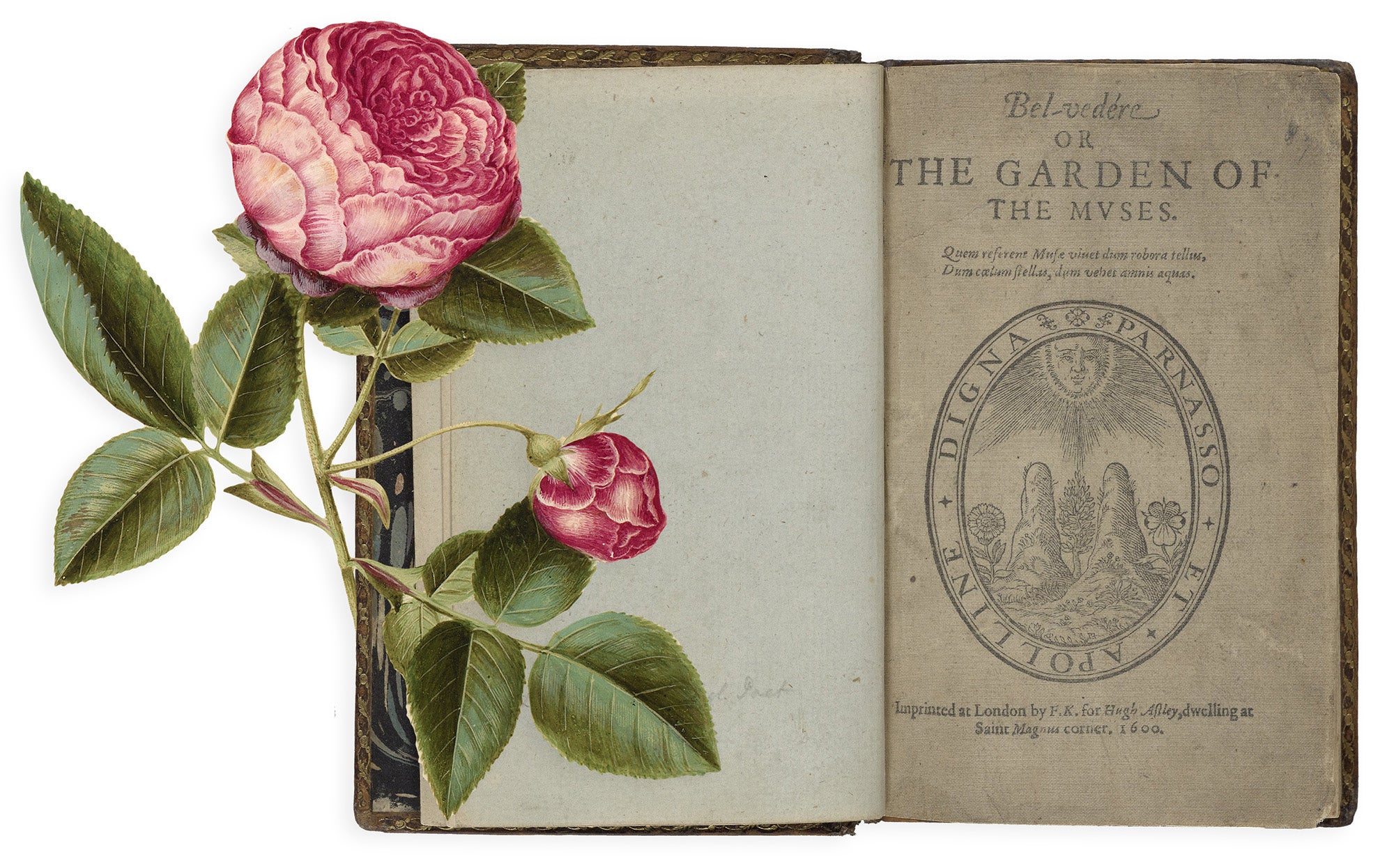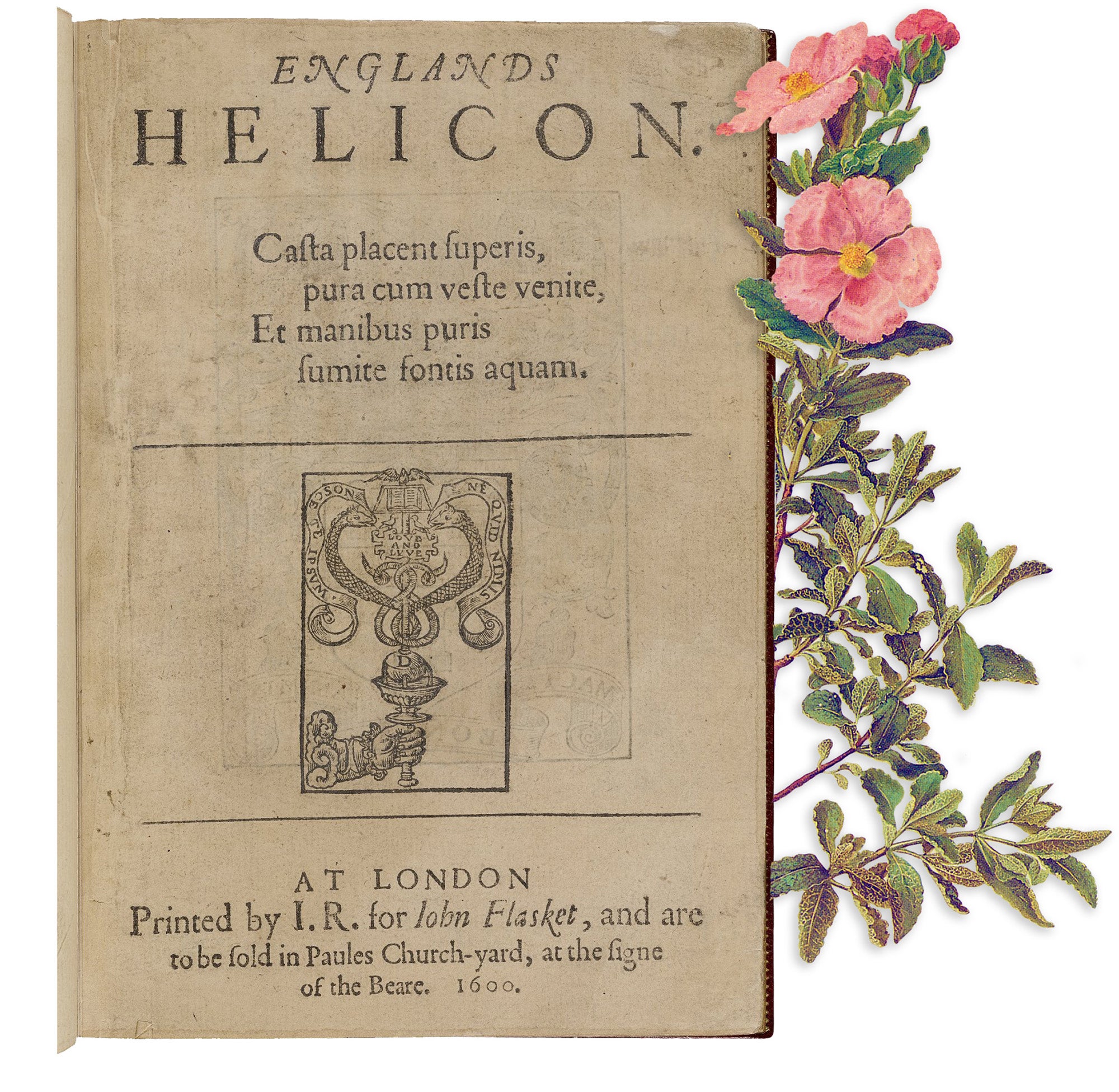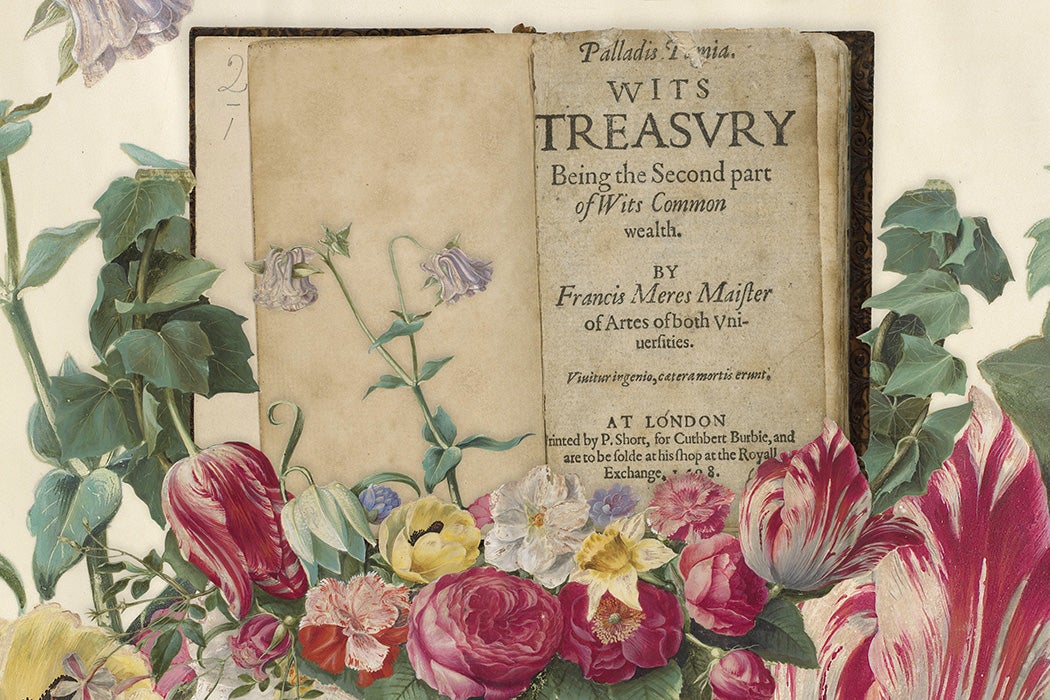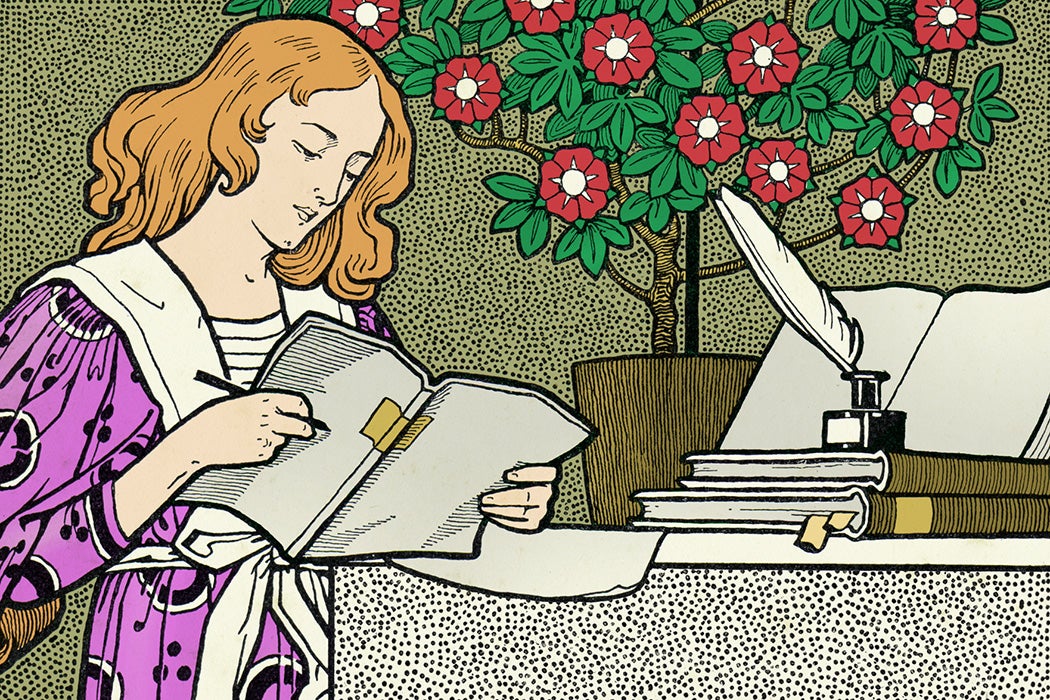In September 1598, not far from the handsome courtyards of London’s Royal Exchange, the bookseller Cuthbert Burby began selling a popular title. Most of Palladis Tamia: Wits Treasury; Being the Second Part of Wits Commonwealth was not written by Francis Meres, whose name was on the cover. More accurately, the Cambridge and Oxford-educated Meres was its editor or compiler as Palladis Tamia is a “commonplace book,” a volume that offered a record of what its compiler found beautiful, edifying, and illuminating. The act of editing in such volumes was intended to be an account of the mind learning, the soul contemplating.
Drawing from a tradition with antecedents in antiquity, the practice of editing a commonplace book required a student to collect fragments of writing that interested them—portions of dialogue, bits of sermons, selections of poems—and arrange them together. “Spurred on by their schoolmasters and university tutors, readers from the sixteenth and seventeenth centuries… gathered quotations from myriad sources in their personal manuscripts,” writes Fred Schurink in Huntington Library Quarterly, reflecting the “widely differing interests and backgrounds of their compilers, notebooks survive in a bewildering variety of shapes and forms.” When it came to commonplace books, humanists were content to let a million gardens bloom. John Milton, Samuel Taylor Coleridge, Mark Twain, Virginia Wolf, Thomas Hardy, and even H.P. Lovecraft devoted hours to the editing of these personal collections (Meres’ was interesting in that it was printed and popular, but the form wasn’t rare).
“We extract only those things which are choice and excellent,” wrote the English philosopher John Locke in his 1685 treatise A New Method of Making Common-Place-Books, “either for the matter itself, or else the elegancy of the expression.” For his commonplace book, Meres most famously mentioned a dozen plays by William Shakespeare, which was crucial in the proper dating of the bard’s works. He also included a section entitled “Comparative Discourse of our English poets with the Greek, Latin, and Italian poets” that compiled an assortment of favorite lyrics.
In the Middle Ages, commonplace books were known by the Latin word florilegium, which translates as “a gathering of flowers,” the operative metaphor being that pressing your favorite excerpts of literature into a book was as if assembling a bouquet. Far from representing an edited canon of the best that had been thought and said, these commonplace volumes were understood to “be something you would gather and give to someone special,” as Christopher M. Kuipers writes in Originality, Imitation, and Plagiarism: Teaching Writing in the Digital Age, more a lover collecting a garland of poesies than a synod deciding on scripture.
The botanical metaphor wasn’t lost on Meres, who wrote that, “As in a vine clusters of grapes are often hid under the broad and spacious leaves, so in deep, conceited and well-couched poems, figures and fables, many things very profitable to be known do pass by a young scholar.” To Meres, and those in the commonplace book tradition, a conscious compiler is as a vintner, a thoughtful editor is as a gardener. The writers and their poems are the grapes and flowers. Today the word florilegium is basically extinct, but the Greek translation of that genre appears in libraries and bookstores, on syllabi and reading lists: anthology.
While easy to overlook a form so omnipresent, as Addison Hibbard gushes in College English, the most exemplary of collections “show how much poorer our literary record would be without [them]. From The Greek Anthology to the current Short Stories from the New Yorker the chronicle of the anthology is both long and honorable.” So familiar is this bibliographical accoutrement—think of the Norton doorstopper favored in undergraduate surveys and the bible-paper of the Longman, the genteel classicism of Christopher Ricks’ The Oxford Book of English Verse and the iconoclastic ecumenicism of Rita Dove’s The Penguin Anthology of Twentieth Century American Poetry—that it can be strange to think of the editing of such collections as an equivalent creative act to the work therein. Crucial then to remember that “Artistic creation, for humans at least, never begins ex nihilo,” as Kuipers writes. “Rather, literary creativity, like all kinds of art, is a process.”
Kuipers enumerates the ways in which the editor is an artist in their own right, their discernment and taste crucial to the selection of material, its arrangement into a unique form, and the presentation of that assemblage. This is a creative act that depends not on Parnassian inspiration in the Romantic mold, but rather an artistry of “cutting a record, framing and displaying,” as Kuipers writes. Certainly this was the artistry of a commonplace book such as Meres’, where the genius which was extolled wasn’t that of the poet, but rather of the mind capable of appreciating it, and this was a variety of brilliance that could be found among different anthologizers, where, as poet Rachel Hadas notes in New England Review, “the best poetry anthologies give the impression of being… personal statements, even personal testaments,” for by selecting, arranging, and introducing poetry in a “certain light, the anthologist appropriates and transforms it for the reader.”

Strictly speaking, a commonplace book was closer to what was known as a miscellany, whose very name announces the idiosyncrasy of each individual project, whereas anthologies-proper developed a reputation for completism. Barbara M. Benedict argues in Making the Modern Reader: Cultural Mediation in Early Modern Literary Anthologies that the “intellectual climate contributed to the commercialization of commonplace books… as printed guides to culture.” Where Meres’ work made no claim to being an authoritative guide to what was worth reading, anthologies became, Benedict writes, “digests of important works.” Indeed, there wasn’t much particularly novel in Palladis Tamia; Meres’ commonplace book wasn’t the only of its kind sold by Burby, as it was part of a series that included John Bodenham’s Politeuphuia, Wits Theater, and Belvedere, or the Garden of the Muses, as well as the England’s Helicon from publisher Nicholas Ling. Nor was Burby the first to sell such works, whether they were called florilegia or anthologies. Regardless, what Meres and those in his stead represent are the intermediary forms between miscellanies and anthologies.
Ironically, one of the first anthologies proper in the English language designated itself Tottel’s Miscellany after its compiler and printer, though its actual title is Songs and Sonnets. Assembled in 1555, four decades before Meres, Tottell’s Miscellany served “to the honor of the English tongue, and for profit of the study of English eloquence” while simultaneously purging the national literature of any “swine-like grossness,” according to Richard Tottel, who included the works of early Renaissance masters Thomas Wyatt and Henry Howard, Earl of Surrey in his edited collection of lyric poems. By affixing Wyatt and Surrey as linguistic geniuses, equal to Latin, Italian, and French poets, Tottel performed a creative act that arguably surpassed that of even those poets he championed. Furthermore, it’s a claim willed into reality in the sixteenth century and remains the scholarly consensus concerning Renaissance English literature, where the lyric is valorized as the consummate form, with Wyatt and Surrey understood as the importers of the sonnet into England.
Benedict explains in The Yearbook of English Studies that Tottel’s Miscellany was “reprinted at least eight times before 1600… [and] stood as a major piece of literary culture,” while R.D. Perry in Coterie Poetics and the Beginnings of the English Literary Tradition: From Chaucer to Spenser succinctly describes the anthology as “the first best seller of English lyric poetry.” Arguably more than just that, for Tottel claimed something rather different from those happily copying away in their commonplace books; he did not merely assemble poems which he fancied, but rather made an argument about their importance and greatness, and by proxy the importance and greatness of English itself. Tottel’s ostensible purpose wasn’t to edify, entertain, or even enlighten; he was attempting to do something akin to what those royal counselors of 1611 were striving for with their authoritative version of the Bible—to canonize.
Anthologies are in some sense a product of secularism. Right at the moment that scripture itself began to lose some of its own authority, literature filled that void of meaning; anthology editors attempted to do for literature what theologians and ecclesiastical councils did for scripture: to present an authoritative, official, and sanctioned version of what’s worth reading. If Tottel’s anthology merely functioned as a brief for the importance of the authors whom he championed, then by the nineteenth century, anthologizers enraptured to the Romantic valorization of literature as sacred made the comparison to scripture explicit. Nowhere is this clearer than in the celebrated and influential Golden Treasury of the Best Songs and Lyrical Poems in the English Language (also called the Golden Treasury of English Songs and Lyrics) whose first edition was assembled by Francis Turner Palgrave in 1861. An aristocratic, Oxford-educated schoolmaster with a borderline religious enthusiasm for poetry, Palgrave set the initial canon for English verse as if he were a bishop deciding on which texts to include in the Bible.
Teaching Resource
Make Your Own Poetry Anthology
With some modesty, Palgrave wrote in a letter to a colleague several months after the book’s release that “It sells well and seems not only to give pleasure, but to arouse thoughts and discussion about poetry, which I regard as the causa finalis of such a book,” though discussion was the least of what he was after. The purpose of the Golden Treasury was nothing less than enshrining the poets whom Palgrave picked into an eternal canon. Though the anthology itself is rarely read today, much less used in college surveys, the aesthetic standard which Palgrave set is unmistakable. He explained in his preface that his motivation was estimably Romantic, and that the greatest function of verse is that “each Poem shall turn on some single thought, feeling, or situation.” For Palgrave, the greatest function of poetry was this expressive contemplation, reflected not just in his anthology, but in its tremendous subsequent influence. The Golden Treasury would canonize Wyatt as Tottel did beforehand, along with his contemporaries Philip Sidney, Edmund Spenser, Christopher Marlowe and William Shakespeare, as well as dozens of other writers including Andrew Marvell, Lord Byron, William Blake, John Keats, Percy Shelley, and William Wordsworth (a uniformly male selection, you’ll note).
An “immediate success” upon publication, the “Golden Treasury achieved quasi-scriptural status,” says Christopher Clausen in The Place of Poetry: Two Centuries of an Art in Crisis. Gone was the informality of the commonplace book, even the relatively measured arguments of a Tottel, in favor of something that treats literature as religion, anthologies as the Bible, and editors as scribal prophets. “Palgrave’s aim, however guardedly expressed, was an ambitious one,” writes Clausen, “to create a standard of English poetic taste.” Despite being largely known today for a surname associated with a major American publisher, Palgrave is as influential as the poets he adored; as Clausen explains it, with this editor the “approved tradition” of English poetry took form. By the Victorian era the secular humanities had, at least for many of the highly-educated such as Palgrave, come to replace traditional religion. Unlike the casualness of the commonplace writer merely collecting blossoms that catch their fancy, Palgrave “warns in his preface that the omission of any hitherto highly regarded poem through inadvertence is unlikely: he has with great care decided what fits and what goes out,” writes Clausen. A perusal of Palgrave’s table of contents shows what the editor’s own preferences (or prejudices) were, from the approval of lyric poetry over other forms to its profound chauvinism. “Whether the anthologist bewailing his dilemma knows it or not,” writes Hadas, “poetry anthologies involuntarily foster limits and exclusions at least as much as inclusions and liberations.” Unlike the humble commonplace editor, Palgrave may have claimed that his vision was universal—but that doesn’t mean we have to agree.
The Golden Treasury, for what it’s worth, is a well-done anthology. From the selection of poems to their organization across four separate chronological sections, it gives an overview of English literary history that if not universal, at least comes from the perspective of a learned and widely-read editor with an eye towards arrangement (which is all we can hope of any anthology). If we’re to understand editorial work as creative, it ironically requires us to elevate the compiler to artist at the expense of the compiler as unassailable prophet, and the anthology itself as a work of art. In other words, as a commonplace book. Now, Palgrave’s claim to completism can be read as literary conceit, not myopia, and our own relationship to such a work can be as a conversation rather than genuflection. Perry writes that “each new generation creates anew the tradition that they inherit as they inherit it,” while Paul Lauter in MELUS observes that “An anthology, after all, is like a culture itself, a work always in progress.”
Free the editor from the burden of omnipotence and the reader is also freed, to no longer take opinions as conclusions, evaluations as commandments, or appraisals as conclusive. And, in turn, the student and reader can, in the greatest tradition of Renaissance humanism, respond with their own positions. Kenneth Warren in American Literature suggests that professors would do well to abandon putting massive anthologies on their syllabi. Instead, as he wrote in 1993, they should encourage their students to purchase large ring binders and “be encouraged to remove, reshuffle, or add texts (including their own creative work) to the binder, with the proviso that they also insert commentary explaining their reasoning.” They should, that is, make their own commonplace books.
In the era of Spotify and Instagram, Reddit and Tumblr, how much easier is it to compile such a thing today, a digital commonplace book in opposition to the anthologizers, all of us democratically restored to a sprinkle of gardeners, each collecting their own bouquet of roses or lilies, tulips and lilacs, these things which we have loved, and that maybe others might be able to love as well.








